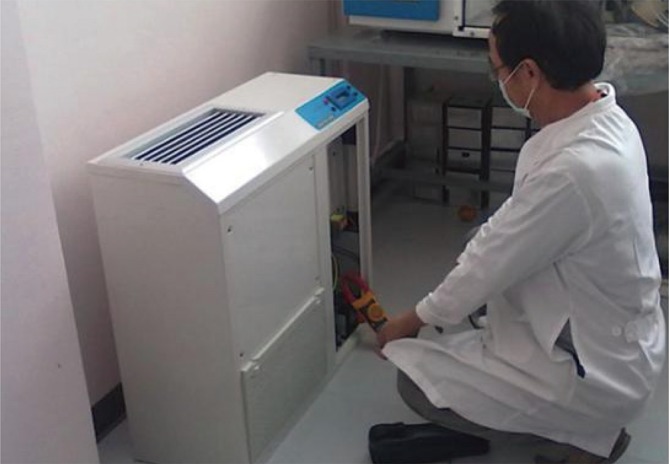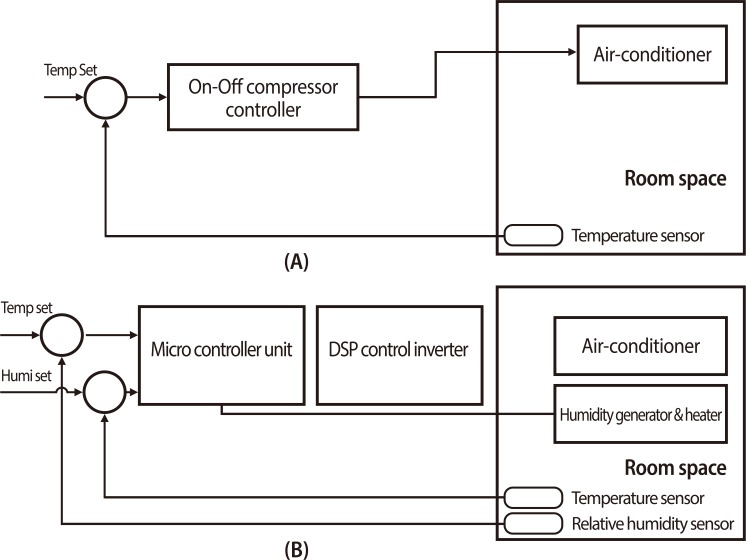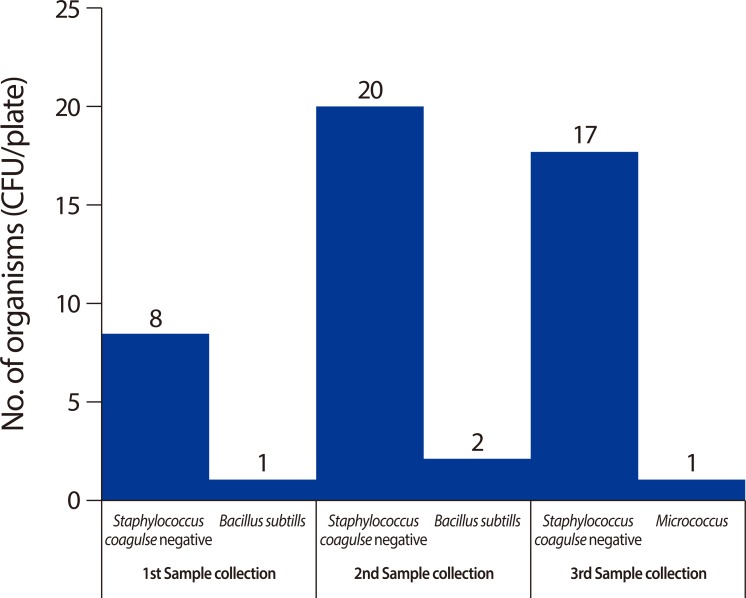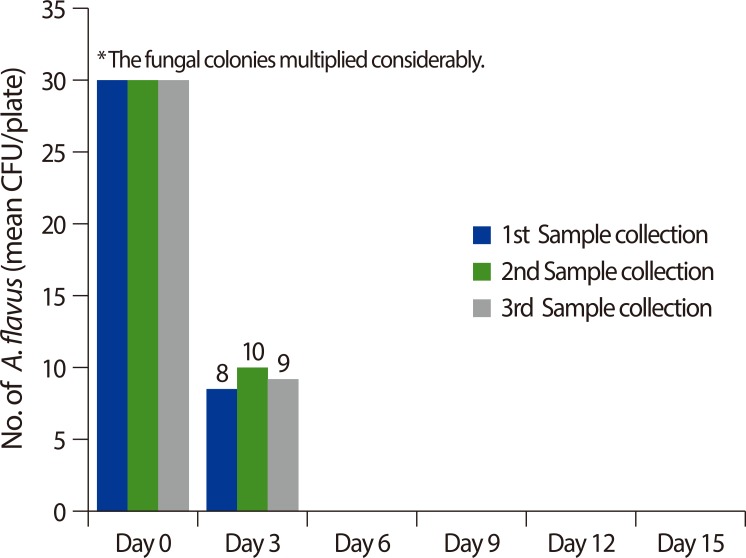Asia Pac Allergy.
2014 Apr;4(2):113-118. 10.5415/apallergy.2014.4.2.113.
Efficacy of the Precise Climate Controller on the reduction of indoor microorganisms
- Affiliations
-
- 1Department of Otolaryngology, Phramongkutklao Hospital, Bangkok 10400, Thailand. pana.ent@gmail.com
- 2Department of Microbiology, Phramongkutklao College of Medicine, Bangkok 10400, Thailand.
- 3Biochemical Engineering and Pilot Plant Research and Development Unit (BEC), King Mongkut's University of Technology Thonburi, Bangkok 10400, Thailand.
- KMID: 2397114
- DOI: http://doi.org/10.5415/apallergy.2014.4.2.113
Abstract
- BACKGROUND
Nowadays, there are many methods to reduce microorganisms in the air, such as dehumidifier, air purifier or humidity and temperature controller. The Precise Climate Controller is an instrument for controlling humidity and temperature, a concept that is demonstrated.
OBJECTIVE
To determine the efficacy of this device, in order to reduce the quantity of the fungi and bacteria in the closed system.
METHODS
This study is a perspective experimental study and is conducted as follows - the air sample in the closed system, a 42-cubic-meter room, is collected before the installation of the Precise Climate Controller. Next, the room is fumed with Aspergillus flavus and closed for 2 days. Then the instrument is in use in order to keep the relative humidity (RH) and the temperature constant at 55% RH and 25 degrees Celsius (℃). The air samples are collected every 3 days for 5 times during the period of 15 days to identify the type and calculate the quantity of the microorganisms.
RESULTS
Before the Precise Climate Controller has been installed. Three species of bacteria are found in the air samples, but none of the fungus exists in the testing room. Once the room has been fumed with a large amount of A. flavus and the instrument is in use for 3 days, nine colonies of A. flavus are identified, but later on when the instrument is in use for 6, 9, 12, and 15 days, the air samples contain neither fungus nor bacteria.
CONCLUSION
After keeping the RH and temperature of the closed system constant at 55% RH and 25℃ by using the Precise Climate Controller, it is found that the efficaciousness in controlling the quantity and species of fungi and bacteria is clinically significant.
Keyword
MeSH Terms
Figure
Reference
-
1. Bunnag C, Jareoncharsri P, Tantilipikorn P, Vichyanond P, Pawankar R. Epidemiology and current status of allergic rhinitis and asthma in Thailand: ARIA Asia-Pacific Workshop report. Asian Pac J Allergy Immunol. 2009; 27:79–86. PMID: 19548633.2. Gravesen S. Fungi as a cause of allergic disease. Allergy. 1979; 34:135–154. PMID: 40448.
Article3. Denning DW, O'Driscoll BR, Hogaboam CM, Bowyer P, Niven RM. The link between fungi and severe asthma: a summary of the evidence. Eur Respir J. 2006; 27:615–626. PMID: 16507864.
Article4. Li DW, Kendrick B. A year round comparison of fungal spores in indoor and outdoor air. Mycologia. 1995; 87:190–195.5. Wraith DG, Cunnington AM, Seymour WM. The role and allergenic importance of storage mites in house dust and other environments. Clin Allergy. 1979; 9:545–561. PMID: 519837.
Article6. Sterling EM, Arundel A, Stering TD. Criteria for human exposure to humidity in occupied buildings. ASHRAE Trans. 1985; 91(Pt 1):611–622.7. Reisman RE, Mauriello PM, Davis GB, Georgitis JW, DeMasi JM. A double-blind study of the effectiveness of a high-efficiency particulate air (HEPA) filter in the treatment of patients with perennial allergic rhinitis and asthma. J Allergy Clin Immunol. 1990; 85:1050–1057. PMID: 2191991.8. Sheikh A, Hurwitz B, Shehata Y. House dust mite avoidance measures for perennial allergic rhinitis. Cochrane Database Syst Rev. 2007; (1):CD001563. PMID: 17253461.
Article9. Arundel AV, Sterling EM, Biggin JH, Sterling TD. Indirect health effects of relative humidity in indoor environments. Environ Health Perspect. 1986; 65:351–361. PMID: 3709462.
Article10. MacIntyre DA. Response to atmospheric humidity at comfortable air temperature: a comparison of three experiments. Ann Occup Hyg. 1978; 21:177–190. PMID: 697270.11. Eng WG. Survey on eye comfort in aircraft: I. Flight attendants. Aviat Space Environ Med. 1979; 50:401–404. PMID: 464966.12. Siriraj Dust Mite Center for Services and Research. Department of Parasitology, Faculty of Medicine Siriraj Hospital. Mahidol University. Precise climate controller for eliminating house dust mites: test report. Salaya: Mahidol University;2012.13. Sookahaiya T, Monyakul V, Thepa S. Assessment of the thermal environment effect a human comfort and health for the development of novel air conditioning system in tropical regions. Energy Build. 2010; 42:1692–1702.14. Bernstein JA, Levin L, Crandall MS, Perez A, Lanphear B. A pilot study to investigate the effects of combined dehumidification and HEPA filtration on dew point and airborne mold spore counts in day care centers. Indoor Air. 2005; 15:402–407. PMID: 16268830.
Article15. Sublett JL. Effectiveness of air filters and air cleaners in allergic respiratory diseases: a review of the recent literature. Curr Allergy Asthma Rep. 2011; 11:395–402. PMID: 21773748.
Article
- Full Text Links
- Actions
-
Cited
- CITED
-
- Close
- Share
- Similar articles
-
- Fungi in Indoor Environment
- A Study on Experiments the Environmental Conditions and the Adaptation of the Human Body in the Vinyl House
- Effects of Heat Wave on Body Temperature and Blood Pressure in the Poor and Elderly
- Climate change and allergy
- A study on accuracy and application of the implant torque controller used in dental clinic





